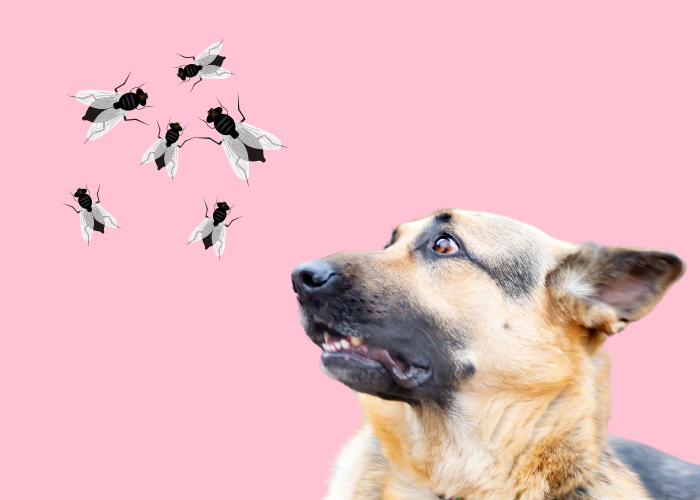Introduction: Common Dog Fears and the Fear of Flies
The world can be a daunting place for our canine companions, as they grapple with an array of fears ranging from loud noises to unfamiliar environments. Among these concerns, the fear of flies is a relatively unusual but not entirely unheard-of issue for some dogs. This article aims to delve into the root causes behind this specific fear, explore how it manifests, and provide strategies to help pet owners support their dogs in overcoming this aversion.

Understanding Canine Fear: Instinct, Experience, and Manifestations
Canine fear is a complex interplay between instinct and experience, often stemming from a dog’s natural response to perceived threats. While some fears are hardwired into a dog’s DNA, such as the fear of predators, others arise from personal experiences or associations formed throughout their lives. Fear can manifest in various ways, from subtle behavioral changes like cowering or avoidance to more overt signs like growling, barking, or even aggression. It is crucial for pet owners to recognize these signs and take appropriate steps to address the underlying causes, ensuring their furry friend’s well-being and happiness.
Unraveling the Fear of Flies: Causes and Contributing Factors
When it comes to the fear of flies, several factors could be at play. Negative past experiences, such as being bitten or stung by a fly or other flying insect, can leave a lasting impression on a dog, instilling an aversion to these winged creatures. Additionally, dogs are often sensitive to sound and movement, with the buzzing and erratic flight patterns of flies potentially causing distress or anxiety. In some cases, an underlying anxiety disorder or phobia may exacerbate a dog’s fear of flies, transforming an otherwise innocuous insect into a source of terror. Lastly, health-related factors, such as impaired vision or hearing, can contribute to a heightened sense of vulnerability, making dogs more susceptible to developing fears like the one in question.
Identifying Signs of Fear in Dogs: Behavioral and Physiological Indicators
Recognizing fear in dogs involves observing both their behavior and physical responses. Some common behavioral signs of fear include hiding, whining, and pacing, which may indicate a dog’s discomfort or anxiety. On the physiological side, panting, trembling, and dilated pupils can also signal fear. Being aware of these signs helps pet owners understand their dog’s emotions and take appropriate action to comfort and support them.
Helping Your Dog Overcome Fear of Flies: Strategies and Techniques
To help your dog conquer their fear of flies, a variety of approaches can be employed. Gradual desensitization involves slowly introducing your dog to flies in a controlled setting, allowing them to become more comfortable with their presence over time. Counter-conditioning involves changing your dog’s emotional response to flies by pairing the insect’s presence with positive experiences, such as treats or praise. Creating a safe space for your dog to retreat to when they feel scared can also provide comfort and security. If your dog’s fear persists or worsens, seeking professional help and training from a veterinarian or animal behaviorist may be necessary.
Preventive Measures and Tips for a Fear-Free Environment
Taking preventive measures can help reduce the likelihood of your dog developing a fear of flies. Implementing fly control methods, such as using screens on windows and doors, can minimize the presence of flies in your home. Reinforcing positive experiences by rewarding your dog when they remain calm around flies can help build their confidence. Finally, maintaining a calm and stress-free environment for your pet can also contribute to their overall emotional well-being, making it less likely for them to develop fears or anxieties.
- Can I Use Ajax to Wash My Dog? [Guide]
- Why Does My Dog Keep Biting His Privates?
- Will a Dog With Bloat Pee? – Bloat and Its Effects on Urination
Conclusion
In conclusion, it’s essential to understand the various factors that can contribute to a dog’s fear of flies, such as past experiences, sensitivity to sounds and movements, and underlying health conditions. Recognizing the behavioral and physiological signs of fear can help pet owners address their dog’s concerns and provide the necessary support. Employing strategies like gradual desensitization, counter-conditioning, and creating a safe space can aid in overcoming this fear.
Understanding and addressing your dog’s fear is an integral part of responsible pet ownership, and by doing so, you contribute to their overall happiness and well-being. Encouraging a positive and stress-free environment for your pet not only helps prevent the development of fears and anxieties but also fosters a stronger bond between you and your furry companion.

Doctor of Veterinary Medicine (D.V.M.) at Nation Taiwan University,Master of Science (M.S.) in Biomedical Engineering at National Taiwan University of Science and Technology




